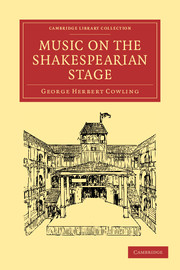Book contents
- Frontmatter
- PREFACE
- Contents
- LIST OF ILLUSTRATIONS
- Introduction
- CHAP. I Music in pre-Shakespearian drama
- CHAP. II An Elizabethan Stage and its music
- CHAP. III Musical instruments and their uses
- CHAP. IV Incidental music
- CHAP. V Musicians, Singers and Songs
- CHAP. VI Elizabethan music, and its share in the drama
- CHAP. VII Some literary allusions to music in Elizabethan plays
- Bibliography
- Appendix
- Index
CHAP. III - Musical instruments and their uses
Published online by Cambridge University Press: 07 September 2010
- Frontmatter
- PREFACE
- Contents
- LIST OF ILLUSTRATIONS
- Introduction
- CHAP. I Music in pre-Shakespearian drama
- CHAP. II An Elizabethan Stage and its music
- CHAP. III Musical instruments and their uses
- CHAP. IV Incidental music
- CHAP. V Musicians, Singers and Songs
- CHAP. VI Elizabethan music, and its share in the drama
- CHAP. VII Some literary allusions to music in Elizabethan plays
- Bibliography
- Appendix
- Index
Summary
Before we attempt to describe the part music took in an Elizabethan play, it is necessary to say something about the musical instruments. They may be classified as follows:
Percussion. Drums, Timbrels, and Bells.
Brass instruments. Sackbuts, Trumpets, and Horns.
Wood instruments. Cornets, Hautboys, Recorders, and Fifes.
Viols. Treble-viols, Viols da gamba, Bass-viols.
Lutes. Treble-lutes, Citterns, Pandores, Bass-lutes.
Drums were of two kinds. The big drum or tabourine was used for playing military marches and national marches (such as that indicated by the direction “Danish march” in Hamlet, where the court enters to see the play), or funeral marches (like that at the close of King Lear, “Exeunt with a dead march”). Small drums called timbrels were hoops of wood covered with parchment only on one side. They were probably used in masquers' processions and in plays dealing with the East. They were employed at The Rose theatre, but there are no stagedirections indicating their use.
It was on the drum or tabourine that the drummers played their “alarums,” that is to say drum-rolls to indicate that a battle was being fought, and also “retreats.” They were employed on the stage, and also behind the scenes if it was desired to imitate a distant battle. Directions for alarums are so numerous in historical plays that it is not necessary to give instances. They can be found by dozens in Shakespeare's Histories, even in the First Folio; and later editors have inserted them in great profusion.
- Type
- Chapter
- Information
- Music on the Shakespearian Stage , pp. 42 - 64Publisher: Cambridge University PressPrint publication year: 2009First published in: 1913



